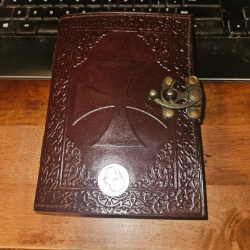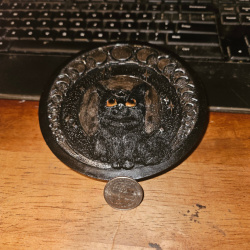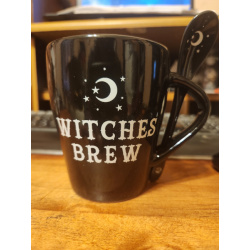Latest Products
-
 Knights Templar Leather Journal
$50.00
Knights Templar Leather Journal
$50.00 -
 Sacred Eye Journal
$50.00
Sacred Eye Journal
$50.00 -
 Black Cat with Moons Incense Burner
$15.00
Black Cat with Moons Incense Burner
$15.00 -
 Witch's Brew Mug w/ Spoon
$13.00
Witch's Brew Mug w/ Spoon
$13.00
Clary Sage - Salvia sclarea
1 OzClary Sage is an herbaceous biennial or short lived perennial, growing to about 1 meter, although the range varies with different cultivars. The green-grey leaves are, quite simply, huge! They are 30cm long at the base and may be up to 50cm long as they move up the stems, and as wide as a hand span in some cases. The leaves are arranged in pairs around the hair covered, square brownish stems. They are oblong and heart shaped with a wrinkled, velvet like texture and toothed margins. The summer blooming flowers are held in bracts that range in color from pale mauve to lilac and extend up long, loose terminal spikes. The 2.5cm corolla is a lilac or pale blue and sits wide open, with the most colour on the margins. There are several modern cultivars, including ‘Turkestanica’ with pink stems and white flecked flowers on long 75cm spikes. They are strong bee and butterfly attractants and apiarists often plant them for their bees.
The whole plant has a strong aroma, which some say is very like lavender and others say it is like pineapple. Still further descriptions suggest that it is a musky aroma that is either loved, or hated and likened to an ‘old socks’ smell. The aroma is courtesy of the active constituents in the plant. Salvia sclarea has a long history of medicinal use and is currently grown commercially mostly for its essential oils.
Clary Sage is an ancient plant and centuries ago there were many garden varieties that went by names such as Horminum and Gallitricum. The plant may also go by the name Clear Eye and Eye Bright (different then the herb known as Eyebright - Euphrasia officinalis) in reference to early medicinal uses.
The English name Clary is derived from the Latin ‘sclarea’, which is from the word ‘clarus’ meaning ‘clear’. This was due to the use of the plant to clear eyes, and the name clary eventually became ‘clear eye’ in many areas.
Clary Sage is native to the northern Mediterranean, specifically Syria, Italy, Southern France and Switzerland. It also grows naturally in some areas of northern Africa and central Asia. It has been naturalized to many areas of Europe and throughout the world. The salvia family has over 900 members with an extensive history as culinary, medicinal and ornamental plants.
Ornamental salvias have become collectors’ items, as gardeners try to find a place in their garden for each and every one. There are salvias that will suit every type of soil and climate.
Medicinal Uses
Clary Sage has a strong tradition of medicinal use and is used by herbalists today, mostly in it's essential oil form.
Traditionally it was used for numerous complaints, in particular stomach and digestive problems, kidney complaints and for insomnia. In the 1st Century, the medicinal use of clary sage was mentioned in writing by Dioscorides and Pliny the Elder, while Theophrastus wrote about the herb in the 4th Century. In 1653, clary sage was recorded as being called ‘clear eye’ due to its value in removing foreign objects from eyes.
Today herbalists use it for a variety of purposes including treating depression, anxiety and fear, as an antispasmodic, and to treat menstrual concerns. Clary sage may be used fresh or dry. However, it should not be used by pregnant women.
An old herbal remedy was to use ‘the juice of the herb, drunk in ale or beer, as a treatment for women’s disorders.’
In Jamaica, where the plant grew naturally, local people used clary sage to help heal ulcers, inflammation of the eye, and in combination with coconut to cure scorpion stings.
Culinary Uses
Today, Clary sage is used as flavoring in vermouths, wines and liqueurs. In 1822, a writer detailed the use of Clary Sage in wines and as hops for beers. In Germany, the plant is called Muscatel Sage, due to the early use of the plant, combined with Elderflower, to flavor Rhenish wines giving them a taste similar to Muscatel.
Magical
Magically, Clary Sage is associated with vision. It is used to clear not only the physical eye, but also the third eye of the clairvoyant prior to channeling or divination. It lifts the spirit and helps detachment from emotionally difficult or painful situations. With emotional distance one gains a better perspective. It can be an aid to enter trance and or to induce euphoria, which is why it is also sometimes used as an aphrodisiac
- Availability: 13 In Stock





